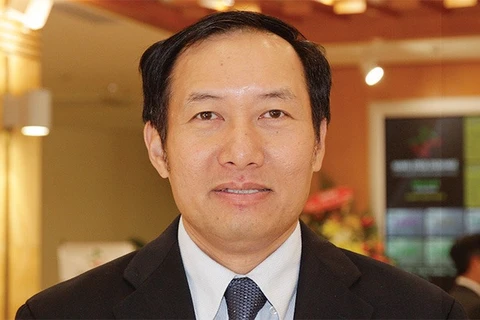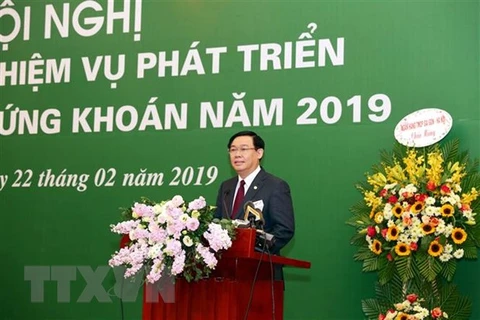Hanoi (VNA) - Prime Minister Nguyen Xuan Phuc’s decision on January 7 which ratifies the Proposal on founding Vietnam Stock Exchange attracts great public attention despite what Deputy Minister of Finance Huynh Quang Hai had said during a conference reviewing State Securities Commission (SSC)’s operation in 2018. In the conference, he pointed out that merging Hanoi Stock Exchange (HNX) and Ho Chi Minh Stock Exchange (HoSE) is among the Commission’s important tasks in 2019.
In order to provide interested people with more information, Ta Thanh Binh, head of the Market Development Department at SSC grants an interview to Vietnam News Agency on the topic.
- The Government’s ratification of Vietnam Stock Exchange’s foundation upon parent-subsidiary model which rearranges the structures of HNX and HoSE has surprised the public. Could you please make it clearer how it works?
Madame Ta Thanh Binh: Many people are surprised and even feel not convinced about the foundation of Vietnam Stock Exchange under the parent-subsidiary model.
However, up to this point, the Government has only approved the Proposal, but yet to issue a decision on foundation of Vietnam Stock Exchange. According to the Proposal, the Vietnam Stock Exchange is founded on the basis of merging HNX and HoSE. They are still two legal entities and could be considered subsidiaries of Vietnam Stock Exchange.
The establishment of Vietnam Stock Exchange aims at eliminating shortcomings of the two independent exchanges. Specifically, the current operation of the two independent exchanges results in an inconsistent trading system.
The independent operation of the two exchanges has cause a great waste of public resources. It also imposes high costs on investors and stakeholders.
Not to mention, there are duplications in several divisions of the exchanges, including administration, R&D and international cooperation.
Many countries around the world have the same tendency of merging domestic exchanges to enhance competitiveness in the world arena.
In Vietnam, the Proposal of founding Vietnam Stock Exchange with capital redirected from HNX and HoSE is considered a premise for healthy development of stock market in Vietnam.
Vietnam Stock Exchange will focus on Research and Development, international cooperation and administrative works which the both exchanges have been doing individually.
- Does Vietnam Stock Exchange add more personnel, which has already been a burden for the sector? How other countries deploy the similar model?
Madame Ta Thanh Binh: It can be sure that there are no additional personnel but staff of the two exchanges will be mobilized to work for the parent exchange. The remaining staff at subsidiaries will focus on operating exchanges with commodities identified in the restructuring itinerary which has already been approved.
The model has been applied in Japan as they merged Tokyo Stock Exchange and Osaka Stock Exchange in 2013 into Japan Stock Exchange. Under the parent-subsidiary model, the two subsidiary exchanges still manage different markets with different products. The model has also been reviewed for approval in the Republic of Korea and Singapore.
- With the goal of turning Vietnam into a startup nation, can you provide more information on building of a stock exchange for start-ups to facilitate their fund-raising?
Madame Ta Thanh Binh: A stock market for start-ups is necessary. Yet, start-ups stocks are unpopular and risky as they are yet to go public and operate in sectors with high risk; while there are lots of requirements to be met when an enterprise wants IPO. If the requirements are strictly adopted, it is very difficult for start-ups to go IPO.
Therefore, start-ups need an exclusive stock market with different regulations. The State Securities Commission has been consulting the nearby markets, such as Thailand with an online trading platform for start-ups using blockchain as well as necessary legal documents of the market. In the draft Law on Securities submitted to the Government, the Commission also leaves it opened for the future development of an exclusive stock market for start-ups.
- What are your opinions on the development of Vietnam’s stock market this year?
Madame Ta Thanh Binh: Stock market in 2018 was highly volatile due to external factors. Given the unexpected occurrences in the world trade market, sustaining foreign capital in the market was a highlight. Foreign investors continued to buy in a net value of 2.8 billion USD with total portfolio value of 32.8 billion USD last year.
As observing the trading sessions, it could be seen that foreign investors sell but do not withdraw money from their accounts, signaling their trust and positive expectations in the future market in medium- and long-term.
In 2019, the world market is even more volatile while Vietnam is more integrated. Therefore, negative impacts are unavoidable. However, with positive signals from the domestic economy and Government’s efforts in ensuring sustainable growth, the resilience capacity of Vietnam’s stock market against external factors will be enhanced.
Besides, SSC will deploy more measures to improve quality and scope of the market, as well as introduce new products in line with international standards in derivative market, improve product quality, accelerating the issuance of the Law on Securities, enhance market inspection and surveillance to attract investors. The stock market this year is expected to continue thriving.-VNA
























